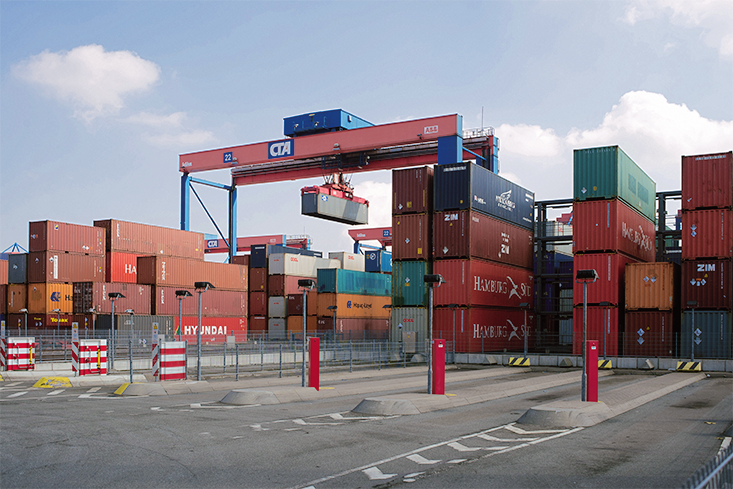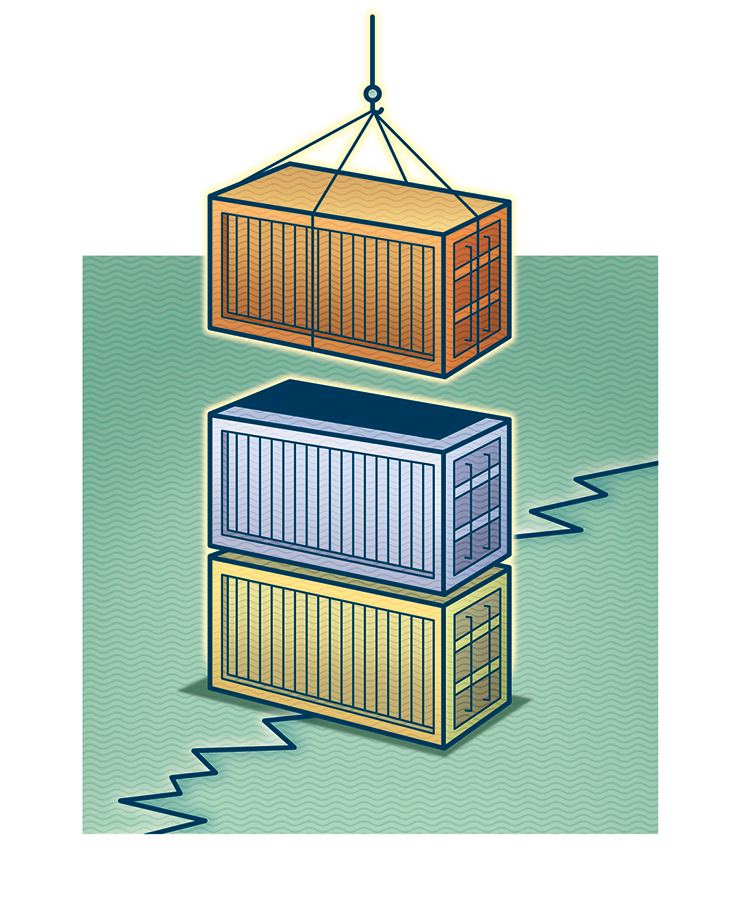It was 11:30 am on a sunny Tuesday in mid-April, and the Hong Kong Express had been docked at Hamburg’s Container Terminal Altenwerder for exactly 33 hours. Already, the ship was half empty. Cargo from Asia was stacked in neat rows of shipping containers on the dock.
Standing in its shadow, it’s hard to appreciate just how big the Hong Kong Express is. From stem to stern, it’s 1,200 feet, nearly a quarter of a mile; from side to side it’s 157 feet, about as wide as some mega yachts are long. Fully loaded, it can carry 13,167 20-foot-long containers, the standard box used in commerce around the world. Laid end to end, that many boxes—each one containing anything from T-shirts to TVs to truck parts—would stretch for 50 miles.
As the spring sun climbed higher, glinting off the placid Elbe River, some cranes nestled containers into towering metal racks on the ship’s deck while others lifted boxes out. At full tilt, Altenwerder’s custom-built cranes can simultaneously load and unload more than 150 containers per hour. Already, full racks of Asia-bound cargo towered 50 feet above the deck, corrugated steel containers stacked like Lego blocks six deep. Still more hid unseen within the behemoth’s matte crimson hull.
Before Wednesday dawned, the Hong Kong Express would be underway once more, sailing 70 miles down the Elbe to its mouth on the North Sea. Once it edged away from the Hamburg dock, its progress amounts to a snapshot of global commerce: first a brief westward sail to the English port of Southampton, then nearly a month chugging at 25 miles per hour to Singapore.
After a brief stop, the vessel worked its way north. By early June, it would edge into Busan, South Korea. Next stop, China: first Shanghai, then to Ningbo bordering Hangzhou Bay, and finally to the megacity of Shenzhen. It would return once more to Singapore before wheeling about and heading back toward Europe.
In less than two months the Hong Kong Express called at 11 ports and traveled more than 12,500 miles. Circling the world four or five times a year, it can move 1.4 million tons of cargo annually. That’s the equivalent of 1.8 billion iPads. The ship is a link in a long, complicated, and precise global supply chain made possible by the humble boxes on board.
More than any other single innovation, the shipping container—there are millions out there, all just like the ones stacked on the Hong Kong Express but for a coat of paint and a serial number—epitomizes the enormity, sophistication, and importance of our modern transportation system. Invisible to most people, they’re fundamental to how practically everything in our consumer-driven lives works.
Think of the shipping container as the Internet of things. Just as your email is disassembled into discrete bundles of data the minute you hit send, then re-assembled in your recipient’s inbox later, the uniform, ubiquitous boxes are designed to be interchangeable, their contents irrelevant.
Once they enter the stream of global shipping, the boxes are shifted and routed by sophisticated computer systems that determine their arrangement on board and plot the most efficient route to get them from point to point. The exact placement of each box is a critical part of the equation: Ships make many stops, and a box scheduled to be unloaded late in the journey can’t be placed above one slated for offloading early. Imagine a block of 14,000 interlocked Lego bricks—now imagine trying to pull one out from the middle.
The container’s efficiency has proven to be an irresistible economic force. Last year the world’s container ports moved 560 million 20-foot containers—nearly 1.5 billion tons of cargo altogether. Though commodities like petroleum, steel ore, and coal still move in specially designed bulk cargo ships, more than 90 percent of the rest—everything from clothes to cars to computers—now travels inside shipping containers. “Reefer” containers, insulated and equipped with cooling units, carry refrigerated cargo and are plugged into power sources on ships or at dockside. Because the containers are all identical, any ship can move them.
Those already huge numbers are expected to grow. Increasingly, cargo companies are looking for ways to move bulk cargo in containers, fitting the steel boxes with bladders to transport liquid chemicals or cleaning them and using polypropylene liners to move anything from soy, corn, and wheat to salt and sugar.

Imagine a block of 14,000 interlocked Lego bricks—now imagine trying to pull one out from the middle.
Even cars and trucks—known in the trade as “RoRo,” or “roll-on, roll-off” cargo—are increasingly being loaded into containers rather than specialized ships. “Containers are just a lot easier,” says James Rice, deputy director of the Center for Transportation and Logistics at MIT. “A box is a box. All you need is a vessel, a berth, and a place to put the container on the ground.”
By driving the cost of shipping internationally way down and the speed of global commerce way up, containers made the globalization of manufacturing possible. Yet for all the concept’s seeming simplicity, the actual process is fiendishly complex.
To get a sense of how the system works, imagine one of the containers aboard the Hong Kong Express, which is owned by German shipping giant Hapag-Lloyd. Asked to trace a product through a typical container voyage, Hapag-Lloyd spokesman Rainer Horn suggests a T-shirt sewn at a factory near Beijing, the kind you might buy at H&M.
Tagged, folded, and boxed, the T-shirt would be “stuffed” into a container with 33,999 identical shirts at the factory. Once sealed with a plastic tag and listed on a computerized manifest, the merchandise could pass through nearly three dozen steps before arriving at a discount clothing retailer’s distribution center near Munich. There’s the trucker who moves the box to a waiting ship in Xinjiang, the feeder ship that moves it to Singapore to be loaded onto a bigger Europe-bound freighter, the crane operator in Hamburg, customs officials, train engineers, and more.
Yet the container’s uniformity smooths each step of the way. Trucks and trains are fitted to haul the identical boxes; cranes are designed to lift the same thing over and over. The total time in transit for a typical box from a Chinese factory to a customer in Europe might be as little as 35 days. Cost per shirt? “Less than one U.S. cent,” Horn says. “It doesn’t matter anymore where you produce something now, because transport costs aren’t important.”
Though containers today seem ubiquitous—so much a part of the modern landscape that they’re used for cheap housing on the outskirts of Berlin, snow removal in Helsinki, and disaster relief in Haiti—the steel boxes are actually a fairly recent phenomenon. Hamburg has been a major European port for nearly a millennium, going back to the days of the Hanseatic League, a federation of free ports around the North and Baltic Seas that thrived in the Middle Ages. For nearly all of that time, shipping was essentially the same: Each vessel was laboriously loaded and unloaded by hand, a process that could take weeks. Longshoremen laid hands on each piece of cargo that went into a ship’s hold, packing bags of grain, wood crates, and pallets into “breakbulk” ships piecemeal. It was a difficult, dangerous job, with unpredictable results; theft, breakage, and delays were common.
Shippers and manufacturers acted accordingly: “So long as cargo was handled one item at a time, with long delays at the docks and complicated interchanges between trucks, trains, planes, and ships, freight transportation was too unpredictable for manufacturers to take the risk that supplies from faraway places would arrive on time,” writes Marc Levinson in his definitive history of the container, The Box: How the Shipping Container Made the World Smaller and the World Economy Bigger. Parts were sourced locally, or purchased far in advance and stockpiled in warehouses until needed.
“A box is a box. All you need is a vessel, a berth, and a place to put the container on the ground,” says Rice.
It took a pugnacious North Carolinian named Malcom McLean to launch the container revolution. An ambitious truck-company owner with little experience when it came to shipping, McLean—who had made a fortune in trucking in the boom years after WWII—was looking for a way to move goods up and down the East Coast’s traffic-choked highways faster and more cheaply.
His inspired idea: Put truck trailers on ships and bypass the roads altogether. Trucks could roll their trailers onto ships in North Carolina; the trailers would be unloaded in New York and hitched to trucks, then driven the rest of the way to their destinations. He soon refined the concept even further, doing away with the trailer wheels and axles, which couldn’t be stacked, and settling for just the trailer body. On April 26, 1956, McLean’s first container ship—a military-surplus WWII tanker—sailed from Newark to Houston loaded with containers custom-built for his company, Pan-Atlantic.
Around the same time, other companies began introducing their own primitive containers—as much a response to theft and breakage as to inefficiency. The boxes came in all shapes and sizes, from 4.5-foot-wide steel-framed crates with plywood sides to steel boxes 15 feet long. Some were designed to be lifted in and out of ship holds using cranes, others with forklifts. Cranes belonging to Grace Lines couldn’t unload containers belonging to Pan-Atlantic.

To fulfill their potential, dozens of players—from shipping companies to railroads and truck chassis manufacturers—had to agree on a standard. Years of debate, overseen by a little-known government agency called the United States Maritime Administration, resulted in a 1961 agreement that only ships built to carry boxes 10, 20, 30, and 40 feet long would be eligible for federal subsidies. A few years later, the International Standards Organization agreed on a common design for corner fittings, making it possible to standardize cranes, too. The resulting steel rectangle—20 feet long, 8 feet wide and about 8 feet tall—became known as a TEU, or 20-foot equivalent unit. The TEU quickly became the yardstick of global commerce.
The first trans-Atlantic container ships set sail in 1966, filled with whiskey headed to the U.S. and guns on their way to Europe. Liquor bottles were traditionally a target for light-fingered longshoremen, and Scotch exporters were quickly sold on container-sized tanks that allowed them to ship their product in bulk and bottle it in the U.S. On the eastbound voyage, nearly every berth was filled with U.S. military cargo destined for the 250,000 American soldiers stationed in West Germany.
McLean’s idea set a revolution in motion. “The early trans-Atlantic container ships could be unloaded and reloaded more quickly, so containerships spent less time at the dock than breakbulk ships,” says Levinson. “Consequently, each one could make more voyages in the course of a year.”
In the decade that followed, container shipping overcame its rivals with the inevitability of a rising tide. “From whiskey distillers in Scotland to apple growers in Australia, major users of international shipping abandoned breakbulk freight as soon as regular container shipping was able to meet their needs,” Levinson writes. By the mid-’80s, the cost of shipping goods from Asia to North America had fallen by more than 50 percent.
Since then, container traffic has continued its steady climb. The Port of Los Angeles, America’s busiest container port, handled 476,000 TEUs in 1981. Thirty years later, 7.9 million 20-foot containers—almost all of them containing goods on their way from factories in Asia—moved through the port, a 16-fold increase. Hamburg’s four container terminals loaded and unloaded 8.9 million TEUs in 2012. On the long list of global container ports, Hamburg and Los Angeles are middleweights: Shanghai, the world’s largest container port, moves 31 million TEUs each year.
As the idea gathered steam, it brought with it unintentional ripple effects. Some are hard to gauge, like the environmental impact of container shipping. The boxes themselves are simply storage; the pollution involved with in transporting them depends on how they’re moved. Mile for mile, transporting a single TEU using a modern container ship produces just a third of the CO2 it would take to move that same container with a truck. But the fact that containers have led to globalized production and multiple international supply chains means that far more cargo is being moved today than in the days of breakbulk.
Other effects are easier to pin down, like the loss of many dockworkers’ jobs and the death of waterfronts around the world as cargo moves to increasingly automated facilities on or beyond city limits. New York is a great case study: Levinson estimates that in 1951, nearly 13 percent of jobs in New York City depended on the city’s ports. Three decades later, nearly all of those jobs were gone. In some cases, urban waterfronts are now being reclaimed as prettified public spaces, half a century later.
Overall, the container profoundly changed the way we shop and work. Reliable, cheap transport made possible an explosion in global commerce. That, in turn, had more far-reaching consequences. When the cost of shipping American cotton to China, having it sewn into shirts there, and shipped back to Wal-Marts in the U.S. sank to nearly nothing, for example, the bottom fell out of the American textile industry. A host of other industries followed—leading to the ongoing outsourcing boom—as containers made geography nearly irrelevant. American manufacturing—which represented nearly a quarter of U.S. GDP in 1970—makes up just over 10 percent today.
Containers also changed the manufacturing process itself. The reliability of containerized shipping spawned a new field in business schools around the world, namely supply chain management. In the 1980s, “inventory” became a dirty word. Instead, everyone from carmakers to clothing retailers adopted a “just in time” philosophy, minimizing the time parts sat in the warehouse before being assembled and sold.
That depended on the precise planning and efficiency that identical, interchangeable containers made possible. “When I started in the merchant marine, on a four-month trip to India we’d usually come back two months late and nobody noticed,” says Gerhardt Muller, a retired professor at the U.S. Merchant Marine Academy and author of Intermodal Freight Transportation, an industry standard. “Now everybody jumps up and down if you’re two hours late.”
When the cost of shipping American cotton to China, having it sewn into shirts there, and shipped back to Wal-Marts in the U.S. sank to nearly nothing, the bottom fell out of the American textile industry.
Once shipments became predictable enough to build production and sales schedules around, managers started treating containers like warehouses in motion. By precisely timing the arrival of components, manufacturers could move items from containers directly onto assembly lines or store shelves, bypassing warehouses entirely. “In the ’80s, people realized the container wasn’t just a box for shipping,” says Muller. “Containers were no longer about shipping—they became about logistics.”
They may grease the wheels of global commerce, but those millions of anonymous, identical containers also make for a very long, very vulnerable supply chain. Experts like to talk about “resilience”—how well a system can recover when it’s rocked by a disaster or unexpected failure. Like a precision watch grinding to a halt thanks to a grain of sand, small setbacks can have big consequences. The American power grid, for example, is notorious for its lack of resilience: A tripped generator in Ohio plunged most of the Eastern seaboard into darkness in 2003, affecting 45 million people.
Could the same thing happen to global shipping? With the timely arrival of each container dependent on dozens of things going right, there’s a lot that can go wrong. “Right now, we’ve got too many eggs in too few baskets,” says Muller. In the U.S., two adjacent ports—Los Angeles and Long Beach—handle nearly half of the nation’s container traffic.
MIT’s Rice recently set about calculating the capacity of U.S. ports, and set up an online utility, called Port Mapper, to help operators figure out how to respond if a port were taken out of commission. The nightmare scenario: an earthquake, a terror attack, or a labor strike in southern California. “If something bad happens in L.A. [including Long Beach], every other container port in America would have to have approximately 25 percent extra capacity to absorb all those containers,” Rice says. “That could not be done.” Delays as ships were re-routed to ports in Canada and the Gulf Coast of the U.S. might hold up cargo for weeks.
It’s already happened, on a small scale. In 2002, labor disputes led to a 10-day port lockout on the West Coast. Auto plants in California, accustomed to “just in time” deliveries of parts from Japan, found themselves chartering planes to bring in parts they otherwise would have had shipped, at a cost of $600 per car. When Hurricane Katrina closed ports in and around Louisiana that handle a significant share of America’s food imports and exports, food prices ticked up 3 percent and stayed there for six months as the system struggled to adjust. And Hurricane Sandy closed terminals in Newark and New York for days, forcing shippers to route their cargo to ports elsewhere on the East Coast.
The solution, Rice says, would be more ports operating below their peak capability to create a buffer in case of disaster or unexpected delays. But port operators have no interest in building inefficiency into the system, essentially paying for space and equipment they’re not using just in case of an emergency. “There’s an incentive to work at maximum capacity,” Rice says. “You know port operators aren’t working at 50 percent.”
Indeed, the system is getting more intricate, not less. The port of the future is eerily quiet and empty. At Altenwerder, there’s none of the noise you’d expect at a busy container port. Instead of shouting longshoremen, beeping trucks, honking horns, and growling engines, there’s just the faint sound of gentle waves against the hulls of the ships and low horns of boats making their way along the Elbe.
As the Hong Kong Express takes on its Asia-bound load, the only human being nearby is a lone crane operator in a glass box 20 stories above the water. The crane slides on rails back and forth over the massive ship, manipulating a specially designed “spreader” claw to lift and shift container after container onto curious, truncated trucks. Seemingly nothing but wheels and chassis, the trucks are missing a key element: drivers.
It turns out Altenwerder is one of the world’s few automated port facilities. Underneath the terminal’s blacktop, a grid of 19,000 sensors help guide driverless robot trucks—AGVs, or “Automated Guided Vehicles”—along routes selected for maximum efficiency. The trucks are programmed to move containers from the shipside cranes to another set of cranes, which stack them according to when they’re scheduled to be picked up by trucks or loaded onto trains. “It’s all done by software,” says Karl Olaf Petters, a spokesman for Hamburger Hafen und Logistik AG (HHLA), the company that runs Altenwerder and most of Hamburg’s other cargo terminals.
Ports and shipping companies are working to squeeze still more efficiencies out of an already mature system. Beginning last year, “dual-cycle” algorithms help Altenwerder’s cranes and AGVs load and unload ships simultaneously, reducing time in port to a minimum. The roustabouts, stevedores, and longshoremen who once populated the world’s docks and harbors have given way to engineers and computer specialists; HHLA employs more than 100 people in its IT department.
The port of the future is eerily quiet and empty.
In the name of energy efficiency, the freighters of the future will make the mighty Hong Kong Express look modest. A Danish shipper, Maersk, is at work on what it calls the “Triple-E” class. The vessels are 1,300 feet long, and capable of carrying 18,000 containers at a time, the equivalent of 111 million pairs of sneakers—27 percent more cargo than the Hong Kong Express, currently one of the largest container ships in the world. This latest generation of freighters, under construction now, is slated to enter service some time in the next year.

Muller says Maersk’s new behemoths may be pushing the envelope towards diminishing returns. The issue isn’t the size of ships, but the infrastructure required to load and unload them. Fully unloaded and laid end-to-end, the 18,000 containers aboard one of Maersk’s new ships would stretch for 68 miles. That sheer volume threatens to choke even the largest ports. “Where are you going to put all those containers?” Muller asks. “Ships lose money when they’re sitting alongside the pier. Companies are facing a tug-of-war between efficiency and flexibility.”
Ironically, while ports shave minutes and hours off of their operations, elsewhere the container industry is actually slowing down. In the past few years, container ships—the largest of which now carry 16,000 20-foot containers—have dropped their average speed 3 miles per hour, down to a stately 25 miles per hour, saving up to 30 percent on fuel costs and reducing CO2 and sulfur emissions.
With nearly 20 million containers constantly in motion around the world, the humble container has become an integral part of our lives: The number of 20-foot equivalent units moved is the most important measure of economic well-being you’ve never heard of. So the next time a truck towing a metal box edges alongside you on the freeway, give a thought to the changes it’s wrought—and the possibilities that still lie in the future.
Andrew Curry is a foreign correspondent based in Berlin. More of his work can be found at andrewcurry.com.



























